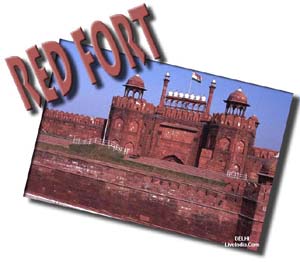|
List
of Hotels in Delhi & New Delhi.....
Red Fort Delhi. Introduction
The largest of Old Delhi's
monuments is Lal Quila or Red Fort whose thick red sandstone walls, bulging
with turrets and bastions, have withstood the vagaries of time and nature.
The Lal Quila rises above a wide dry moat in the northeast corner of the
original city of Shahjahanabad. Its walls extend from two kilometers and
vary in height from 18 metres on the river side to 33 metres on the city
side.
Mughal Emperor Shahjahan
started construction of the massive fort in 1638 and work was completed
in 1648. The fort contains all the expected trappings of the centre of
Mughal government: halls of public and private audience, domed and arched
marble palaces, plush private apartments, a mosque and elaborately designed
gardens. Even today, the fort remains an impressive testimony to Mughal
grandeur, despite being attacked by the Persian Emperor Nadir Shah in 1739
and by the British soldiers during the war of independence in 1857.
Mughal Emperor Shahjahan
started construction of the massive fort in 1638 and work was completed
in 1648. The fort contains all the expected trappings of the centre of
Mughal government: halls of public and private audience, domed and arched
marble palaces, plush private apartments, a mosque and elaborately designed
gardens. Even today, the fort remains an impressive testimony to Mughal
grandeur, despite being attacked by the Persian Emperor Nadir Shah in 1739
and by the British soldiers during the war of independence in 1857.
Entrance to the fort is
through the imposing Lahore Gate, which takes its name from the fact that
it faces Lahore, now in Pakistan. This gate has a special significance
for India since the first war of independence and important speeches have
been made here by freedom fighters and national leaders of India.
The main entrance opens
on to the Chatta Chowk, a covered street flanked with arched cells that
used to house Delhi's most talented jewellers, carpet makers, weavers and
goldsmiths. This arcade was also known as the Meena Bazaar, the shopping
centre for the ladies of the court. Just beyond the Chhata Chowk is the
heart of the fort called Naubat Khana or the Drum House. The musicians
used to play for the emperor from the Naubat Khana and the arrival of princes
and royalty was heralded from here.
The Fort also houses the
Diwan-i-Am or the Hall of Public Audiences where the Emperor would sit
and hear complaints of the common folks. His alcove in the wall was marble-paneled
and was set with precious stones, many of which were looted after the mutiny
of 1857. The Diwan-i-Khas is the hall of private audiences where the Emperor
held private meetings. This hall is made of marble and its centre-piece
used to be the Peacock Throne, which was carried away to Iran by Nadir
Shah in 1739. Today, the Diwan-i-Khas is only a pale shadow of its original
glory, yet the famous Persian couplet inscribed on its wall remind us of
its former magnificence: "If on Earth be an Eden of bliss, it is this,
it is this, none but this."
The other attractions
within this monument are the Royal Baths or hammams, the Shahi Burj, which
used to be Shahjahan's private working area and the Moti Masjid or the
Pearl Mosque, built by Aurangzeb for his personal use. The Rang Mahal or
the "Palace of Colours" housed the Emperor's wives and mistresses. This
palace was crowned with gilded turrets, delicately painted and decorated
with an intricate mosaic of mirrors, and a ceiling overlaid with gold and
silver that was reflected in a central pool in the marble floor.
Even today, the Lal Quila
is an eloquent reminder of the glory of the Mughal era and its magnificence
leaves many wonder-struck and breathless. It is still a calm haven of peace
which helps one to break away from the frantic pace of life outside the
walls of the Fort and transports the visitor to another era of time.
Sound & Light Show
| The eventful history
Red Fort has been witness to is brought out as a sound and light show every
evening on the ramparts of the Red Fort. For those desirous of delving
into Delhi's glorious and tumultuous past, Delhi Tourism puts on a spectacular
sound and light show at the Purana Qila bringing 5,000 years old history
of the city come alive. Special effects combine with the unique ambience
to make this show a hauntingly unforgettable experience. The eternal Jamuna
bears witness to the glorious and tumultuous history of Delhi. It throws
light on a history, which begins with the creation of Indraprastha by the
Pandavas and the transformation of this barren gift of the Kauravas into
an idyllic haven. This show unfolds the history of Delhi. One is transported
centuries back in time to witness Draupadi being reduced to a dasi of Hastinapur,
the gallant Prithviraj Chauhan gallooping away with Samyogita, Sher Shah
Suri being blown to bits by misfired cannon, the legendary Razia Sultan,
Humanyun tragically tumbling down the steps of his library, Bahadur Shah
Zafar surrendering to the British. |
|
This is the story of
the city of cities - Delhi; where a great empire rose and fell before the
dawn of history; citadels of emperors appeared and disappeared. But, combined
and integrated into one, these new cities have always been called Delhi
and Delhi has always been intrinsically identified with power and imperial
sway. These and many more such episodes out of Delhi’s old saga can be
relived during this evocative 62 minutes son et lumiere. Advanced technology
has made it possible to add special effects, combining with the unique
ambiance to make this show a hauntingly unforgettable experience. Shrouded
in antiquity, the lofty walls of the Purana Quila, rise on the sire of
the ancient city of Indraprastha. It is believed to be the site of the
first city of Delhi. The high-rise walls and imposing entrances to the
Quila are credited to emperor Sher Shah Suri. Purana Quila, now the site
for the sound and light show, has seen centuries of history unfold before
it. The show, inaugurated on 2nd October 1996, is perhaps the biggest of
its kind in India. The show each in Hindi and English is held after sunset
except on days when it rains. The shows, through skillful use of light
and sound, bring to life bygone days of Delhi's history from the Mughal
period.
PS.
Evening light shows and
Red Fort.
Monday Closed |









